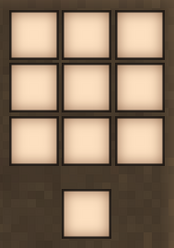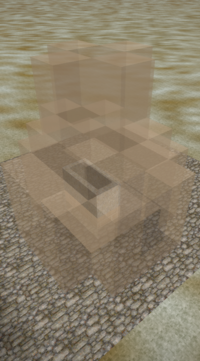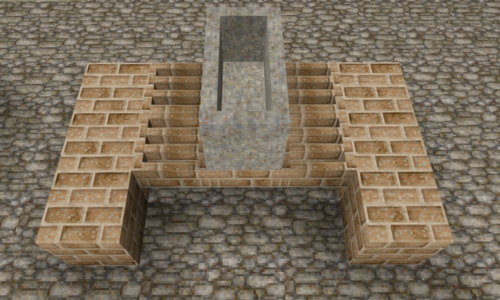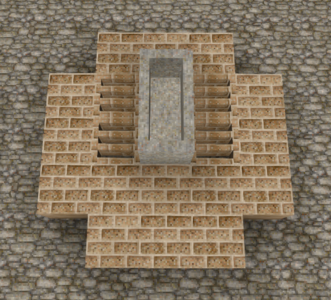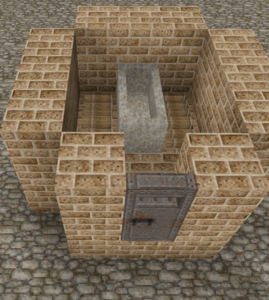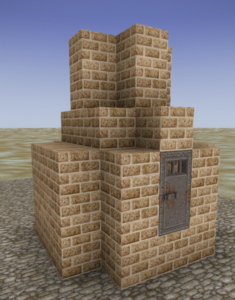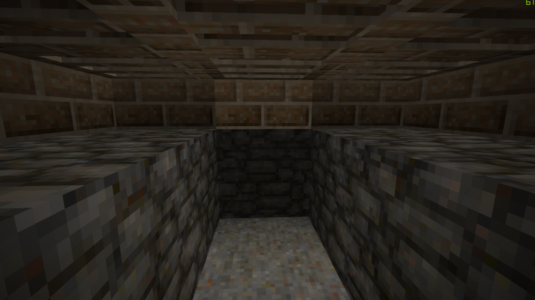Steel making/en: Difference between revisions
(Updating to match new version of source page) |
(Updating to match new version of source page) |
||
| Line 29: | Line 29: | ||
From tier 1 to tier 3, the recipes for raw refractory bricks are as follows: | From tier 1 to tier 3, the recipes for raw refractory bricks are as follows: | ||
<div style="display:flex;flex-wrap:wrap;"> | <div style="display:flex;flex-wrap:wrap;"> | ||
{{Grid/Crafting | {{Grid/Crafting | ||
|A1= | |A1=Fire Clay|B1=Fire Clay|C1= | ||
|A1N=|B1N=|C1N= | |A1N=|B1N=|C1N= | ||
|A2= | |A2=Crushed-quartz|B2=Crushed-bauxite|C2= | ||
|A2N=|B2N=|C2N= | |A2N=|B2N=|C2N= | ||
|A3=|B3=|C3= | |A3=|B3=|C3= | ||
|A3N=|B3N=|C3N= | |A3N=|B3N=|C3N= | ||
|Output= | |Output=Raw Refractorybrick|OA=}} | ||
{{Grid/Crafting | {{Grid/Crafting | ||
|A1= | |A1=Fire Clay|B1=Fire Clay|C1= | ||
|A1N=|B1N=|C1N= | |A1N=|B1N=|C1N= | ||
|A2= | |A2=Crushed-quartz|B2=Crushed-bauxite|C2= | ||
|A2N=|B2N=|C2N= | |A2N=|B2N=|C2N= | ||
|A3= | |A3=Crushed peridotite|B3=|C3= | ||
|A3N=|B3N=|C3N= | |A3N=|B3N=|C3N= | ||
|Output= | |Output=Raw Refractorybrick|OA=}} | ||
{{Grid/Crafting | {{Grid/Crafting | ||
|A1= | |A1=Fire Clay|B1=Fire Clay|C1= | ||
|A1N=|B1N=|C1N= | |A1N=|B1N=|C1N= | ||
|A2= | |A2=Crushed-quartz|B2=Crushed-bauxite|C2= | ||
|A2N=|B2N=|C2N= | |A2N=|B2N=|C2N= | ||
|A3= | |A3=Crushed peridotite|B3=Crushed ilmenite|C3= | ||
|A3N=|B3N=|C3N= | |A3N=|B3N=|C3N= | ||
|Output= | |Output=Raw Refractorybrick|OA=}} | ||
</div> | </div> | ||
<br> | <br> | ||
Raw Refractory bricks need to be baked at 850°C for 27 fuel ticks to turn into Fired Refractory Bricks. Those can then be used to craft their tier specific brick blocks and brick grating blocks. The different tiers of refractory bricks have different heat resistances. Tier 1 has a heat resistance of 90%, Tier 2 has 95%, and Tier 3 reaches 100%. Apart from Tier 3, all other refractory brick blocks will receive damage in each smelting process. Tier 1 will have about 6 damaged blocks per smelting, while Tier 2 breaks about 2-4 blocks. Damaged refractory brick blocks can be broken to return some of their materials back, similar to a broken bloomery. Grate blocks do not get damaged at the moment, which means there is not sense in making them out of higher tier bricks. | |||
<div style="display:flex;flex-wrap:wrap;"> | <div style="display:flex;flex-wrap:wrap;"> | ||
Revision as of 12:50, 2 December 2020
Steel Making is the process of carbonizing iron under high temperatures, for which a new type of furnace building is required.
Required materials
To produce steel, a player needs an iron anvil, a forge, fuel (coal or charcoal) and blister steel ingots.
To obtain blister steel, the player first needs a pulverizer to build a refractory furnace, and fuel (coke or charcoal).
Creating Blister Steel
Blister steel is the first step of creating steel from iron, and functions the same way an iron bloom does. To heat iron up to the required temperatures to make carbonisation possible, the player first needs to build a special furnace structure out of refractory blocks and other specialist blocks.
Creating Refractory Bricks
Refractory blocks come in three different tiers with different heat resistances. They are important for the steel making process as no other currently available block can withstand the extreme heat. To produce refractory blocks, different stone and ore types need to be crushed in a pulverizer first. The powders can then be used in the crafting grid together with fire clay to make unfired refractory bricks. Different compositions of powders are required for the different tiers.
| Material | Stone | Powder | Minimum Pulverizer Cup Tier |
|---|---|---|---|
| Bauxite | 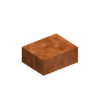 |
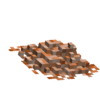 |
Bronze |
| Quartz | 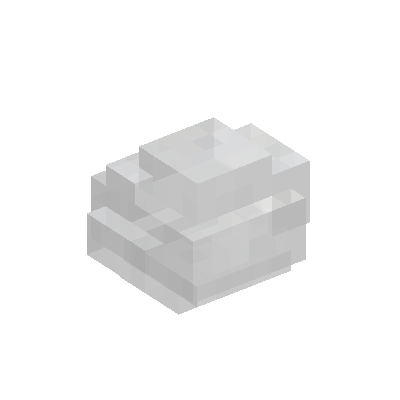 |
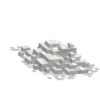 |
Bronze |
| Olivine | 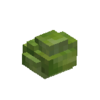 |
Crushed Olivine | Iron |
| Ilmenite | 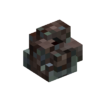 |
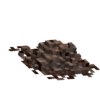 |
Steel |
From tier 1 to tier 3, the recipes for raw refractory bricks are as follows:
Raw Refractory bricks need to be baked at 850°C for 27 fuel ticks to turn into Fired Refractory Bricks. Those can then be used to craft their tier specific brick blocks and brick grating blocks. The different tiers of refractory bricks have different heat resistances. Tier 1 has a heat resistance of 90%, Tier 2 has 95%, and Tier 3 reaches 100%. Apart from Tier 3, all other refractory brick blocks will receive damage in each smelting process. Tier 1 will have about 6 damaged blocks per smelting, while Tier 2 breaks about 2-4 blocks. Damaged refractory brick blocks can be broken to return some of their materials back, similar to a broken bloomery. Grate blocks do not get damaged at the moment, which means there is not sense in making them out of higher tier bricks.
Other Required Blocks
Additionally to the refractory blocks, there are some more specialist blocks necessary to build a functioning steel making furnace, namely an iron door and a stone coffin including a coffin lid.
And iron door can either be found in ruins, or crafted out of 6 iron plates. Stone coffins can be made out of Granite or Andesite.
Building a Refractory Furnace
To build a functioning refractory furnace, the player needs 1 iron door, 2 stone coffin sections and 2 stone coffin lids, 6 refractory brick gratings, 53 refractory brick blocks and a number of dirt or stone blocks to build the coal burning area beneath the furnace structure itself.
The furnace is a multiblock structure that needs to be build in a specific way to ensure it is functioning as intended. When starting the build of a furnace, the player can Shift+right click the stone coffin with coal or an empty hand to trigger a building help overlay. Shift+right clicking will additionally inform the player about the number of still missing or misplaced blocks in the structure.
The player should allocate at least a 5x5 space for the furnace, and additional space to reach the back or side of the furnace to input coal or coke. The furnace structure is 6 blocks high, but an additional layer below the grate blocks is required. The chimney on top of the structure does not have to be open to the sky at the moment, but if it is blocked there will be no smoke indications shown while the furnace is running. Keep in mind that the furnace is, for now, always build with the door side facing in one specific direction, even if the whole structure is already finished and the coffin is added as the last element, the building overlay will still demand to build the structure with a specific orientation, regardless of how the player build it already. The orientation seems to be different from world to world - further testing or code diving needed.
Shopping List
For one refractory furnace, the player would need:
- 6 iron plates = 12 iron ingots
- 4 whole granite or andesite blocks
- 920 fireclay, which is about 15 stacks
- 460 of each powdered ingredient needed, depending on tier, which is about 8 stacks each
The Structure
- First, place the grate blocks and the coffin. These are the centre blocks of the structure. The coffin half will always be placed with the open side towards the player. As soon as the full coffin is placed - without coffin lid, for now - the player can Shift+right click for the building help.
- The full size of the furnace takes up a 5x5 space as shown below.
- Raise the walls up by two blocks, and don't forget to place the iron door at some point in the process.
- Build up the roof, covering every open block with one above in a stair pattern. The finished furnace should have a two high chimney as shown below.
- The confusing part about building a refractory furnace is the space below the actual brick structure. For the process to work, the player needs to be able to access the two spots below the coffin placed on the grate blocks, as the steel making requires fuel layers to be placed on those two blocks. Due to the fact that coal will behave similar to snow if piled up to high, it is recommended to put stabilizing blocks to the side of the two open spaces for the coal. It is not required to close this space off airtight, the player can choose to leave a permanent hole or put in a coke oven door. Note that none of the refractory brick blocks can be removed to access this space, instead the opening needs to be created one block below the lowest brick layer.
- If the structure was build correctly, there will be no further indication of missing or misplaced block when Shift+right clicking the coffin.
Smelting Process
With a finished refractory furnace build, the next step requires the player to fill the coffin.
One stone coffin will hold a total of 16 iron ingots and 40 fuel pieces - either coke or charcoal. Place down one layer of fuel with Shift+right click first, then one layer of iron ingots. Repeat until the coffin is full and will not accept any more items. The coffin should allow 5 layers of fuel with 8 pieces per layer, and 4 layers of iron ingots with 4 ingots per layer.
Once filled, the coffin tool tip will indicate that a coffin lid needs to be placed on top of the coffin. Note that the coffin needs to be filled completely, otherwise the process will not start even if the lid is placed and coal beneath ignited.
After the coffin is closed, the player should leave the burning chamber and close the door. It is not recommended to enter the chamber again in the middle of the smelting process, as the extreme heat inside will cause 5 HP damage per tick if inside while the bricks are still heated. The coffin tool tip will indicate that the process requires fuel to be placed and ignited below the two grates under the coffin.
Access the underbelly of the furnace as shown above from the side or the back of the furnace. Place fuel in equal amounts on the two spaces directly below the coffin. Each fuel layer on one block takes 2 fuel items, meaning a full layer on both blocks requires 4 fuel items. Charcoal, black coal and coke work as possible fuel items. For instance, one such layer of charcoal will give 12% of progress towards finished steel.
When testing out the process in creative or survival, keep in mind that the coffin tooltip might take a few seconds to update correctly from one state to the next, specifically once the player ignites fuel below. The coffin will show the progress in percentages, but again it might take a tick until that progress info is shown correctly. A working furnace will have fire particles inside the burning chamber - which also indicates the danger of stepping inside at that time - as well as smoke rising from the chimney.
Protip:
The coffin will retain the progressed reached, even if the coal burns out before the process is finished! This allows the player to start the process with a low amount of fuel, and add further fuel as needed, or log of from a server without fear to loose progress and materials. |
One firing of 16 iron ingots will reward the player with an equal amount of blister steel ingots.
Making Steel
Blister steel in itself is not yet workable steel, instead it behaves similar to iron blooms, and further refining is necessary. To turn blister steel into steel, it needs to be processed on an iron anvil either by hand or with the help of a helve hammer. Note that the blister steel is less complicated to process by hand then iron blooms, and there is no possibility of pixel loss if processed by hand, making helve hammer processing almost overkill.
| {{{title}}} | |
|---|---|
